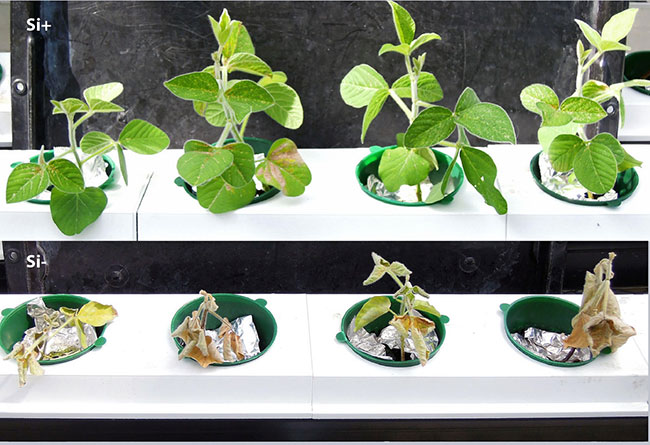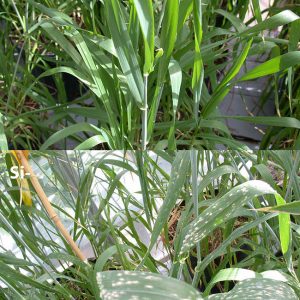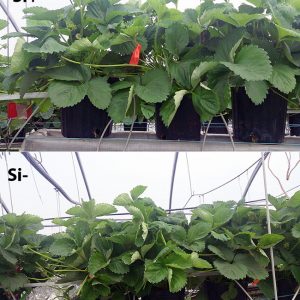
Features
Fertility and Nutrients
Harnessing silicon’s stress-busting power
Research to optimize silicon use in field crops.
August 24, 2021 By Carolyn King
 Bélanger’s group inoculated hydroponically grown soybean plants with Phytophthora sojae and applied a nutrient solution with (Si+) or without (Si-) 1.7 millimolar silicon.Photos courtesy of Richard Bélanger.
Bélanger’s group inoculated hydroponically grown soybean plants with Phytophthora sojae and applied a nutrient solution with (Si+) or without (Si-) 1.7 millimolar silicon.Photos courtesy of Richard Bélanger. Conflicting results and differing opinions have swirled around silicon’s role in plants for many years. But an ever-growing mountain of scientific evidence shows silicon can be effective in protecting plants against a wide variety of stresses. Field crops, of course, always face some sort of stress during the growing season. So it’s no surprise that Richard Bélanger’s diverse research on silicon includes studies with crops like soybean, wheat and canola.
For almost three decades, Bélanger, his research group at Université Laval and his collaborators have delved into the complexities of silicon’s effects on plants. This research ranges from studies that have shed light on how silicon functions within plants on a molecular level, to applied research on the use of silicon fertilizer in greenhouse, horticultural and field crop production.
Using silicon fertilizers on field crops presents some challenges, but Bélanger is hopeful. “We’re trying to develop scientific approaches to optimize silicon’s use. We want to be able to tell growers whether or not it is going to be worthwhile applying it to their crop, give them the scientific basis for that, and help them along the way,” he says.
“Because silicon can be helpful – you can reduce your pesticide use, you can increase your yield through reduction of the losses incurred by different stresses. Under the right conditions, silicon works very well, but there are a lot of factors that are important to understand.”
A few basics about silicon
Silicon (Si) is a very common element. The amount of silicon in a soil depends on various factors, but averages around 30 per cent in mineral soils. However, in most situations, very little of that silicon is in its plant-available form, which is silicic acid.
Furthermore, not all plant species are able to absorb the plant-available silicon. And the degree to which a silicon-absorbing plant can benefit from silicon uptake strongly depends on the stress the plant is exposed to.
Over the years, scientists have generated numerous hypotheses to try to explain how silicon affects plants and have debated whether or not silicon should be classified as an essential nutrient for plant growth.
More recently, the cumulative results from many studies have made two things clearer.
One is that silicon can definitely alleviate the impacts of biotic stresses – such as certain plant diseases and insect pests – and abiotic stresses – like drought, flooding, excessive temperature, nutrient deficiency and nutrient toxicity.
The other is that plants growing under perfect non-stress conditions do not benefit from silicon uptake. Bélanger explains that silicon helps plants to partially or completely recover from stress. But silicon does not improve a plant’s performance beyond what it would have been in a non-stress situation.
Silicon is not an essential nutrient under ideal growing conditions. But its benefits to silicon-absorbing plants in the real world – where plants are always encountering stresses – can be significant. As a result, the International Plant Nutrition Institute has classified silicon as a “beneficial substance.”
Which plant species can absorb silicon?
“Scientists have known for a long time, based on empirical observations, that some plants will not absorb silicon and will have very little silicon in their tissues, while other plants will have quite a bit, and some others will be in between. But we didn’t know the reason for these differences,” Bélanger says.
“Then in 2006-07, it was discovered that silicon entering into a plant was mediated by specific transporters.” Transporters are proteins that help transport water and dissolved substances across cell membranes. Silicon transporters are permeable to silicic acid.
To be able to take up and accumulate silicon, a plant must have two types of silicon transporters. “One type, an influx transporter, takes silicon in the form of silicic acid from the soil solution and brings it into the plant. Then the other type of transporter, an efflux transporter, sends the silicon into the xylem to be translocated into the leaves and other plant tissues, where it will deposit as silica,” he explains.
“Plant species that have these transporters will take up and accumulate silicon. Then, depending on other features that are not completely understood right now, some of these silicon-absorbing plants will accumulate more silicon than others.” Plant species that lack these two transporters will contain only very small amounts of silicon.
Most grasses, including crops like rice, wheat, barley and corn, have the two silicon transporters. Some broadleaf plant species, such as soybean, also have these transporters. Bélanger notes, “Rice is probably the best commercial example of a plant that has very active and very strong silicon transporters.” For example, rice has around four per cent silicon content in its leaves, and soybean has about two per cent.
“On the other hand, there are plant families that do not absorb silicon because they lack these silicon transporters. The best examples are probably the Brassicaceae, such as canola and mustard, and the Solanaceae, such as tomato, tobacco and potato . . . If you measure silicon in a canola plant, you will find a background level, maybe 0.2 per cent, but in essence these plants don’t accumulate silicon.”
Bélanger and his group have done quite a bit of research to increase scientific understanding of silicon uptake in plants. For example, in a study with soybean, they showed that it is the plant’s rootstock – and not transpiration from the leaves – that drives silicon levels in plant tissues.
They have also done applied research on silicon uptake in soybean and other plants. For instance, they evaluated the effectiveness of different silicon fertilizers on soybean under different stress conditions.
As well, they screened more than 1,000 soybean lines and identified the very few lines that are exceptionally good at absorbing silicon. At present, no commercial soybean lines have this high silicon absorption trait. However, Bélanger and his group have created DNA markers to make it much easier for breeders to develop lines with the trait, so, perhaps one day soon, Canadian growers will have high-silicon soybean varieties with an enhanced ability to cope with biotic and abiotic stress.
Which diseases are controlled?
Bélanger explains that the scientific community has also been making headway in recent years regarding exactly how silicon uptake controls plant pathogens.
“Scientists have known for some time that silicon seems to work best against pathogens that are biotrophs or hemibiotrophs. These types of pathogens have an interaction with the plant where they do not aggressively kill the plant; instead they keep it alive so they can establish some kind of a life cycle in the living plant and derive benefits from it,” he notes.
“This type of pathogen-plant interaction depends on the pathogen’s release of what we call effectors. Usually biotrophs and hemibiotrophs are very specific to a particular host plant species because the interaction is based on the recognition between a specific effector and a specific plant receptor. For example, there are many kinds of powdery mildews, and almost every powdery mildew is specific to a particular plant species. So wheat powdery mildew will not attack barley or cucumber or rose, and vice versa.”
The molecules involved in this chemical dialogue between the pathogen’s effector and the plant’s receptor flow along a pathway in the plant called the apoplast pathway. But silicon is known to deposit as silica in this pathway. Recently, Bélanger and his group have found that these silica deposits seem to hinder the release and movement of the effectors to the receptors, preventing the dialogue between them.
“It’s almost like the pathogen no longer recognizes its host,” he says.
Bélanger and his collaborators have investigated the benefits of silicon in controlling various biotrophic and hemibiotrophic diseases, such as powdery mildews in various greenhouse, horticultural and field crops, and Phytophthora root rot in soybean.
He adds, “Phytophthora sojae is a hemibiotroph pathogen, so silicon works well for controlling it. And soybean has other important diseases caused by biotrophs and hemibiotrophs. For instance, we think silicon might be effective against soybean cyst nematode [which is a biotroph].”
Could canola be made into an Si absorber?
Bélanger and his group are currently working on an intriguing project with canola. They want to see if it might be possible to add the two silicon transporters into canola and enable canola to benefit from silicon’s stress-fighting powers.
A few years ago, they conducted some related work with Arabidopsis thaliana, a small plant with a small genome in the Brassicaceae family. Like canola, Arabidopsis lacks the two silicon transporters. The researchers inserted the influx transporter from wheat into Arabidopsis and found that the modified plants could absorb silicon and had improved disease resistance.
“We know that canola is attacked by several important diseases caused by biotrophic pathogens such as Leptosphaeria maculans [blackleg] and Plasmodiophora brassicae [clubroot]. Through discussions with SaskCanola and some producers, we felt that canola would be very interesting to study,” Bélanger says.
“If we were to transform canola with silicon transporters, could we change its intrinsic ability to accumulate silicon and therefore benefit from silicon by becoming resistant to those pathogens?”
According to Bélanger, this project is the first time that anyone has ever tried to add both silicon transporters into a plant. So, this is high-risk research, but if successful, it could lead to significant benefits for canola growers. SaskCanola and the Natural Sciences and Engineering Research Council of Canada are funding the project.
So far, Bélanger’s group has added the influx transporter into canola. This has resulted in a small increase in silicon in the transformed plants. However, the efflux transporter is a much larger and more complicated protein, and adding it is proving to be more difficult.
The researchers have tried several measures to overcome this roadblock, but nothing has worked so far. Now they are considering other possibilities such as trying to add both transporters into Arabidopsis and then coming back to canola.
Soil and fertilizer considerations
“Very few soils contain enough silicic acid to contribute to a high level of silicon in plants,” notes Bélanger.
“Sandy soils have low levels – although sand is mainly silica, it is bound and will not go into solution. Soils that are a bit more organic will have more silicic acid. Generally, depending on the amount of organic matter and the pH, soils have between 0.1 and 0.6 millimolar of silicic acid. The highest possible concentration of silicic acid in solution is 1.7 millimolar.” (Above this concentration, it polymerizes and is unavailable to the plant.)
Most of Bélanger’s silicon research focuses on plant disease considerations, but he has done some soil and fertilizer studies. “In the soils that we have tested in southern Ontario and Quebec, the silicic acid concentrations are extremely low. [We haven’t tested Prairie soils,] but we did some analysis of soils in the United States, including the Midwest, which is more comparable to the Prairies. We found a range in the Midwest, but generally the levels of plant-available silicon are decent there.”
He explains that greenhouse growers have been using silicon fertilizer in their crops for many years because it is easy to provide these crops with plant-available silicon in a solution. The solution is made from a silicate salt like potassium silicate, the solution’s concentration can be adjusted to 1.7 millimolar, and it is applied through a drip irrigation system.
“In field crops, [solid fertilizers] have been used such as wollastonite [calcium silicate] and silicate slags from industries. From the studies that we have done, it seems that the release of plant-available silicon from either the slags or wollastonite is not optimal. We have been working with a company to try to find ways to increase the release of silicic acid, but it is very challenging,” he says.
Bélanger and his group worked with strawberry growers in experiments that compared silicon in solution applied through a drip system and a soil-applied wollastonite fertilizer. “The difference was incredible. With the drip system, strawberry plants accumulated 3 per cent silicon, which is very high, close to the level found in rice. But the strawberry plants in the field with the [solid] fertilizer had 0.3 per cent silicon.”
He adds, “The person who comes up with an affordable, high-release silicon fertilizer would become a millionaire in a hurry because this is one of the limiting factors to applying silicon in field crops.”
Advice to field crop growers
Bélanger is concerned that some silicon fertilizer companies report the benefits of their products in ways that are confusing or unclear.
He gives one example: “To reduce stress, you need to have silicon accumulation in the plants. So I have asked the commercial people: did you measure the difference in silicon accumulation in the plants between the treated plots and the control plots? But they can’t answer that question.” Without that data, you can’t tell if the fertilizer benefit is due to silicon uptake or something else, such as the calcium in a calcium silicate product.
Another example relates to pH levels. “Potassium silicate is extremely alkaline, so once you mix it to the right concentration, the pH will be about 10 or 11. Therefore, you have to adjust the pH before you use it. But some people have claimed to show a toxic effect of silicon on a fungus by adding the solution to the Petri dish without adjusting the pH. So they are trying to grow a fungus on pH 11. Of course, the solution is fungi-toxic but it has nothing to do with the silicon.”
Bélanger emphasizes, “We want to work together with the commercial people, but we want to test their products in the lab to make sure that it is the silicon that is providing the benefit. We are trying to demystify silicon from a scientific point of view so we can give good advice to growers.”
If you are interested in trying a silicon fertilizer on your field crop, Bélanger recommends that you start by testing the product in a small plot and compare the treated and untreated crop.
“Take precise measurements of the plant-available silicon concentrations in the soil and the silicon concentrations in the plants. Then you can draw your conclusions about the benefits of the silicon application without going all out with this technology.”
Check with the soil and plant testing labs in your region to see if they offer these tests. Bélanger’s lab at Laval is specifically equipped to do the tests; for instance, his lab has X-ray fluorescence equipment that very precisely and rapidly measures the silicon concentration in leaves.
“Our ultimate goal is to provide growers with a user-friendly approach where they could gain benefits from silicon fertilization,” Bélanger says.
“Although silicon fertilizer is standard procedure in the greenhouse industry, we are not quite there yet in the field. But we have made a lot of headway in the last 30 years, and if we persevere, hopefully we will get to that point.”

